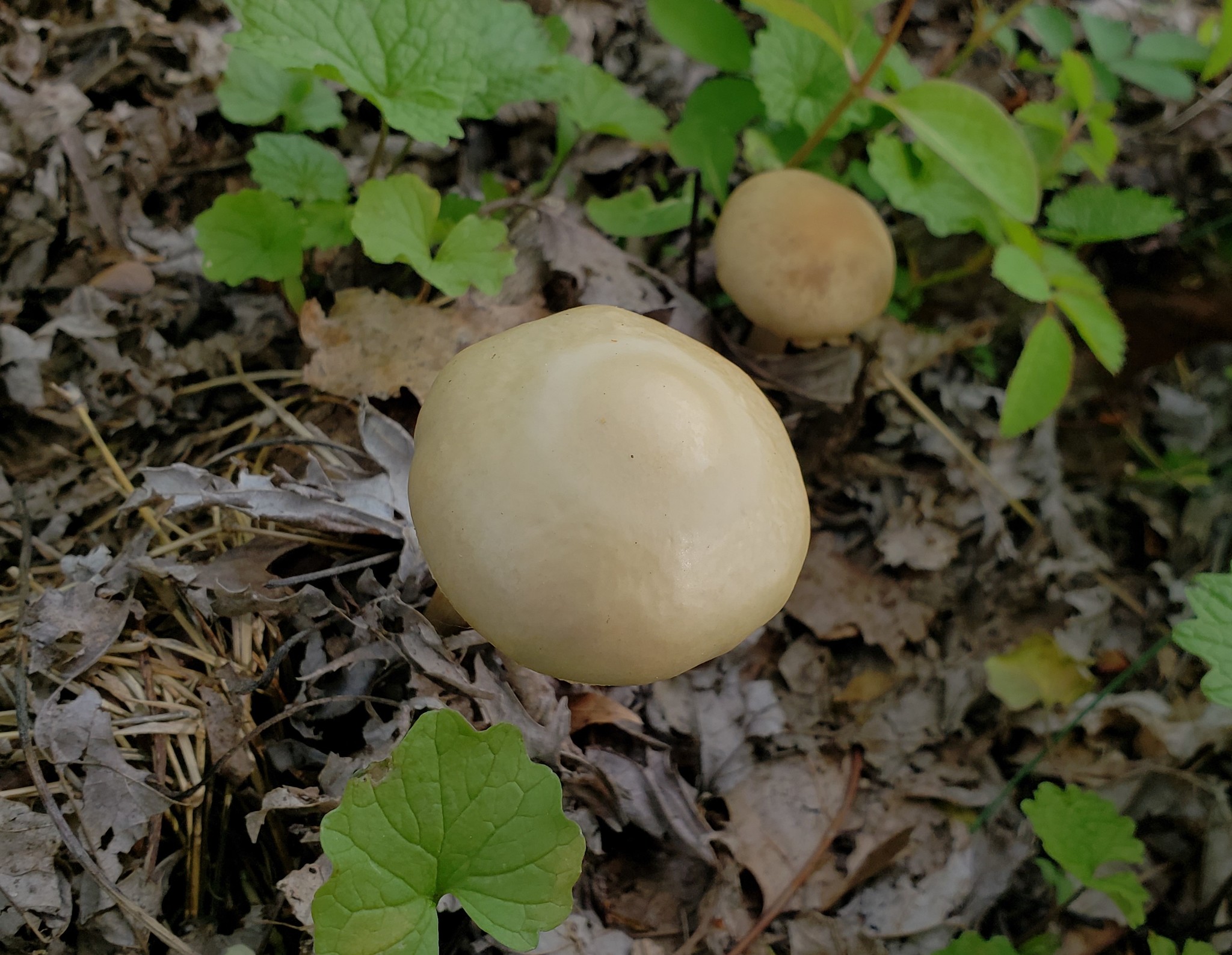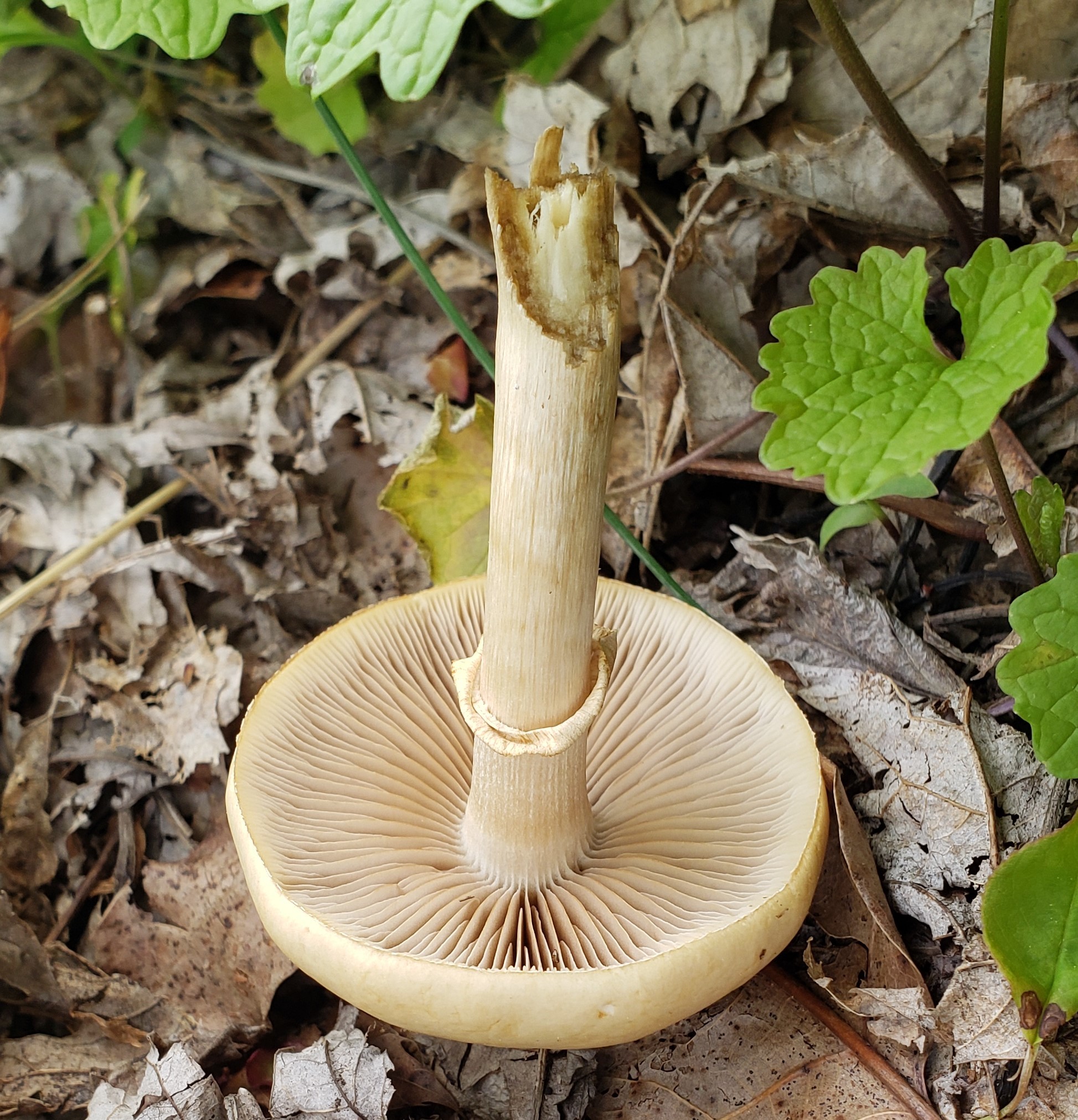Map Snapshot







12 Records
Seasonality Snapshot
Source: Wikipedia
| Agrocybe praecox | |
|---|---|

| |
| Scientific classification | |
| Domain: | Eukaryota |
| Kingdom: | Fungi |
| Division: | Basidiomycota |
| Class: | Agaricomycetes |
| Order: | Agaricales |
| Family: | Strophariaceae |
| Genus: | Agrocybe |
| Species: | A. praecox
|
| Binomial name | |
| Agrocybe praecox | |
| Agrocybe praecox | |
|---|---|
| Gills on hymenium | |
| Cap is convex | |
| Hymenium is adnexed | |
| Stipe has a ring | |
| Spore print is brown | |
| Ecology is saprotrophic | |
| Edibility is unknown | |
Agrocybe praecox, commonly known as the spring fieldcap, spring agrocybe or early agrocybe,[1] is a species of brown-spored mushroom which appears early in the year in woods, gardens and fields. According to modern taxonomic analysis, it is just one of a cluster of closely similar species which are often referred to as the Agrocybe praecox complex. It is found in Europe, North Africa and North America.
Description
[edit]Agrocybe praecox belongs to a group of species which are difficult to distinguish consistently. The following description combines several references.[2][3][4][5]
- Cap: up to 8 centimeters (3.1 inches), convex, smooth, beige when dry and yellowish brown when imbued with moisture. Veil remnants are often visible around the rim.
- Gills: Initially whitish, later dark brown.
- Stem: Pale, 4 to 7 centimeters (1.6 to 2.8 inches) (occasionally up to around 10 centimeters (3.9 inches)), quite thick (to about 1 cm) with a fragile ring. Often with mycelial cords at the base.
- Odor and taste: Floury.[3][4] Taste may be bitter.[2]
- Spores: 8–10 x 5–7 μm,[4] ellipsoid, dark brown (en masse).
- Habitat: Gregarious in grass or on wood debris in woods, gardens, or other contexts. Like other Agrocybes, it is a saprophyte.
- Season: Often observed in spring, but can also occur in summer and autumn.
Taxonomy and related species
[edit]The mushroom was first described by Persoon in 1800 as Agaricus praecox. In 1889 Fayod devised the new genus Agrocybe and made A. praecox the type species.[6]
The Latin epithet praecox ('early')[7] is related to the word "precocious" and refers to the fact that this species often appears early in the year.
A 1990 study by Timothy Flynn and O. K. Miller finds that A. praecox is one of four species which are indistinguishable using superficial characteristics but which can be separated through their habitat and location.[8][9] If this proposal is accepted, the cluster consists of A. molesta and three other species which do not yet have proper names, but which are referred to as "Flynn & Miller Species I–III". The three provisional species correspond to the older names A. acericola, A. elatella, A. praecox, and A. sphaleromorpha combined; and their synonyms.[4][10] According to the traditional system, various detailed morphological characteristics can be used to choose between the species, but such is variation amongst individuals that it is difficult to achieve a consistent identification in this way.
The following table summarizes the names of species which are closely related to A. praecox. Note that Index Fungorum has been used as a reference throughout.[6]
| Species, author & date | Description & References | Relation to A. praecox |
|---|---|---|
| Agrocybe acericola (Peck) Singer (1950) | Found on woody debris in hardwood forests, cap yellow-brown, often veined or wrinkled in the centre. May be the same as Flynn & Miller Species III.[11] | Not distinguished from A. praecox in Funga Nordica.[4] |
| Agrocybe dura (Bolton) Singer (1936) | This is a synonym of A. molesta (the name A. dura is preferred by Funga Nordica).[2][3][4] | See A. molesta. |
| Agrocybe elatella (P. Karst.) Vesterh. (1989) (= A. paludosa) | Grows amongst moss in marshes and fens. | Smaller with more slender stipe, hygrophanous, stem not bulbous.[3][4][5] |
| Agrocybe gibberosa (Fr.) Fayod (1889) | Synonym of A. praecox.[4][12] | Same. |
| Agrocybe molesta (Lasch) Singer (1978) (= A. dura) | This is certainly a distinct species which grows in grass,[2][3][4] but according to Flynn & Miller it is part of the A. praecox complex, and the only species which gets its nutrition from grass (rather than wood chips).[8][9] | It is bigger and fleshier than A. praecox,[2][3][5] the cap surface develops superficial cracks[2][3][4][5] and the spores are somewhat bigger.[2][4] |
| Agrocybe paludosa (J.E. Lange) Kühner & Romagn. (1953) | This is a synonym of A. elatella.[3][4] | See A. elatella. |
| Agrocybe sphaleromorpha (Bull.) Fayod (1889) | Not distinguished from A. praecox in Funga Nordica[4] | Smaller, having a bulbous stipe, found in pasture.[2][3][5] |
| Flynn & Miller Species I (1990) | Temporary name for first proposed new species.[8] | Grows in gardens on wood chip mulch.[9][10] |
| Flynn & Miller Species II (1990) | Temporary name for second proposed new species.[8] | Grows on wood litter in coniferous or aspen forests in western North America.[9][10] |
| Flynn & Miller Species III (1990) | Temporary name for third proposed new species.[8] | Grows on wood litter in broadleaf forests (especially with maples) in eastern North America. May be the same as A. acericola.[9][10] |
General
[edit]It has a widespread distribution in North America,[9] Europe, Asia[13] and North Africa.[3] Also it has been reported from Mongolia, Siberia, Sri Lanka, South Korea, Japan, New Zealand, Argentina and Colombia.[14]
The species is not flavorful but is sometimes considered edible.[7][15] It may be bitter, and one French source says that because of this characteristic and its soft consistency, it is best left aside.[16] Another site says that it is edible but needs to be well cooked.[17] Roger Phillips lists it as inedible.[18]
Another similar species is A. smithii.[7]
References
[edit]- ^ Arora, David (1986). Mushrooms demystified: a comprehensive guide to the fleshy fungi (Second ed.). Berkeley: Ten Speed Press. ISBN 978-0-89815-169-5.
- ^ a b c d e f g h Marcel Bon (1987). The Mushrooms and Toadstools of Britain and North-Western Europe. Hodder & Stoughton. p. 262. ISBN 978-0-340-39935-4.
- ^ a b c d e f g h i j Courtecuisse, R.; Duhem, B. (1994). Guide des champignons de France et d'Europe. Delachaux et Niestlé. p. 360. ISBN 978-2-603-00953-6. Also available in English.
- ^ a b c d e f g h i j k l m Henning Knudsen; Jan Vesterholt (2008). Funga Nordica. Copenhagen: Nordsvamp. p. 828.. Here A. praecox is admitted to be a complex of species including A. acericola and A. sphaleromorpha.
- ^ a b c d e See Meinhard Moser (1983). Keys to Agarics and Boleti. Translated by Simon Plant. London: Roger Phillips. p. 290. ISBN 978-0-9508486-0-0.
- ^ a b For instance, search Species Fungorum with genus name = "Agrocybe" to find the related species. A. praecox is here.
- ^ a b c Trudell, Steve; Ammirati, Joe (2009). Mushrooms of the Pacific Northwest. Timber Press Field Guides. Portland, OR: Timber Press. pp. 178–179. ISBN 978-0-88192-935-5.
- ^ a b c d e Timothy Flynn; O. K. Miller (1990). "Biosystematics of Agrocybe molesta and sibling species allied to Agrocybe praecox in North America and Europe". Mycological Research. 94 (8): 1103–1110. doi:10.1016/s0953-7562(09)81341-5. A synopsis is available online at the Science direct site.
- ^ a b c d e f Kuo, M. (2006, September). Agrocybe praecox. See the MushroomExpert.Com article.
- ^ a b c d See this "Champignons du Québec" page (in French) for a key incorporating the same relationships.
- ^ Kuo, M. (2006, September). Agrocybe acericola. See the MushroomExpert.Com article.
- ^ This page of Species Fungorum shows synonyms of A. praecox.
- ^ Asef M.R. (2020). Field guide of Mushrooms of Iran. Tehran: Iran-Shanasi Press. p. 360. ISBN 978-600-8351-42-9.
- ^ See the Global Biodiversity Information Facility map, which provides hyperlinks to records with geographical location.
- ^ Miller Jr., Orson K.; Miller, Hope H. (2006). North American Mushrooms: A Field Guide to Edible and Inedible Fungi. Guilford, CN: FalconGuide. p. 272. ISBN 978-0-7627-3109-1.
- ^ See the Armorance web site (in French) on the natural history of Brittany.
- ^ See the First Nature site.
- ^ Phillips, Roger (2010). Mushrooms and Other Fungi of North America. Buffalo, NY: Firefly Books. p. 226. ISBN 978-1-55407-651-2.


